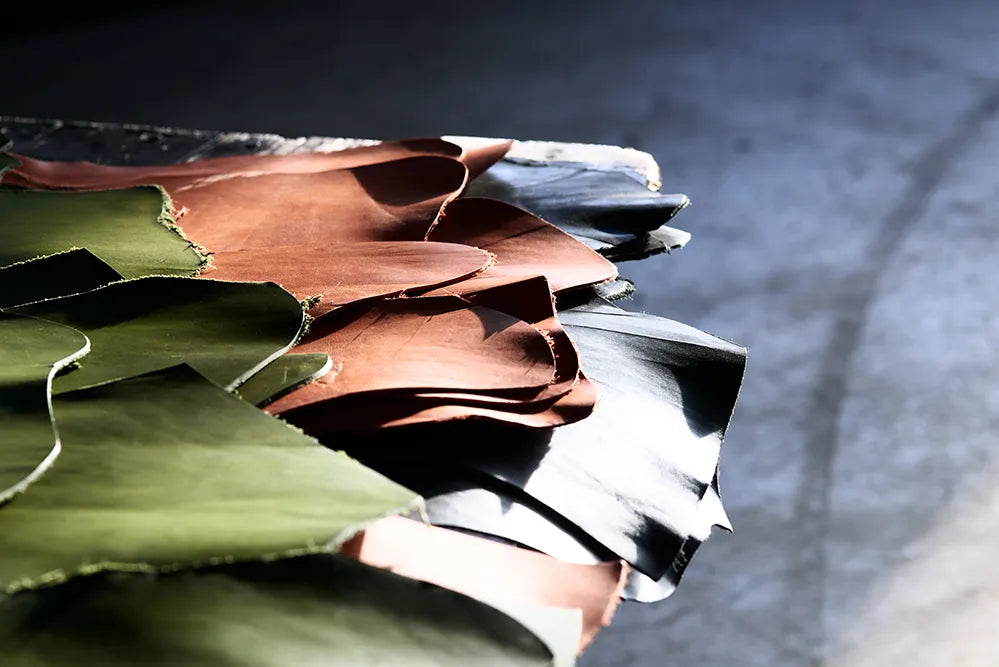

Tochigi Leather is a popular material for watch straps, wallets and leather shoes, made completely free of chemicals. The leather takes on its own original character the more it is used, and its durable and long-lasting properties have earned it a distinguished reputation both in Japan and abroad. However, despite taking an interest, some may wonder how to look after the leather and therefore be reluctant to try it.
In this article we will take a closer look at the characteristics of Tochigi Leather, its manufacturing process, and how to help the leather age at its finest.
Contents
The attractive characteristics of Tochigi Leather
The manufacturing process of Tochigi Leather
How to help Tochigi Leather age beautifully
Enjoy the sumptuous texture of Tochigi Leather in Knot’s original watch straps
What is Tochigi Leather
Tochigi Leather is a vegetable-tanned leather produced by Tochigi Leather Co. Ltd., a tannery located in Tochigi Prefecture.Its unique vegetable-tanned leather is made by tanning cowhide using vegetable tannins, and finishing with a minimal amount of surface treatment. By contrast, most other leathers on the market are tanned using chemicals (basic chromium sulfate) to produce chrome leather.
Tochigi Leather is made using a traditional tanning process, from purchasing the rawhides to tanning them at the company’s own factory. Its high quality is achieved through the dedication of the artisans, who take the time to create their products using traditional methods.
The resulting leather is one of great appeal: supple and resilient, and with a simple yet profound appearance which takes on an even deeper character as time goes by.
Tochigi Leather vs. Himeji leather
In addition to Tochigi Leather, another typical Japan-made leather is Himeji Leather. While Tochigi Leather is the vegetable-tanned leather produced by Tochigi Leather Co. Ltd., Himeji leather is the general name given to all leather produced in and around the city of Himeji in Hyogo Prefecture – a craft which the region is well known for. Both are made in Japan, but the tanning process differs greatly. Tochigi Leather is vegetable-tanned, but Himeji leather is chrome-tanned using chemicals, which makes Himeji leather resistant to deterioration over time.Some Himeji leather is made using both chrome and tannin tanning.
Uses of Tochigi Leather
Traditionally, vegetable-tanned leather has had the reputation of a hard material that is difficult to bring to market. However, Tochigi Leather is made using a unique production method, creating a vegetable-tanned leather that is both supple and durable.Products made from Tochigi Leather are available in a wide range of designs, popular among both men and women. For example, it is found in fashion accessories such as wallets, watch straps, bags, shoes, phone cases and key holders, as well as general goods such as notebook covers, pencil cases and organizers. These items come in a variety of colors, such as brown, black, blue, red, navy and gray, from muted tones to more vivid hues.
The manufacturing process of Tochigi Leather
Tochigi Leather is made by artisans through a number of processes, which we’ll describe below step by step.
How Tochigi Leather is made
1) Washing the rawhideSalted rawhide is washed in a drum for about 24 hours to remove dirt and restore moisture.
2) SplittingTo improve efficiency, the washed hides are split along the spine into two halves, left and right.
3) Lime soaking for hair removalThe hides are sequentially soaked in pit tanks containing limewater with five different concentration levels. This process loosens the collagen fibers and makes it easy to remove the hair.
4) FleshingUsing a machine, the hides are processed to remove internal fat and dirt, as well as to adjust their thickness.
5) Deliming and enzyme treatmentThe hides are neutralized, and their surface is smoothed to prepare them for tanning.
6) Vegetable tanningThe hides are soaked in 160 tanks filled with solutions of plant-based tannins. This crucial step determines the quality of Tochigi Leather. The hides are immersed in progressively stronger tannin solutions, transforming them into durable leather.
7) Water extractionAfter extended soaking in the tannin solution, the leather is washed and passed through a “samming setter” machine to remove excess water.
8) OilingOils and fats are applied to the leather to add softness and luster.
9) StretchingThe leather is stretched using a machine known as a “setter”.
10) DryingThe leather is air-dried naturally for around 10 days. After drying, some of the leather is measured and shipped.
11) SkivingThe thickness of the leather is adjusted according to its intended use.
12) Retanning and dyeingThe leather is tanned again to refine its softness and tanning quality. If coloring is required, it is done during this stage.
13) RestretchingAs dyed leather contains moisture, it is stretched and moisture removed using a samming setter.
14) Hand stretchingThicker or less flexible leather is stretched manually using a hand setter.
15) Moisture removal and dryingThe leather is left for 1-2 days to allow moisture to evaporate. Depending on the season and the thickness of the leather, thinner pieces dry for about 4 days, while thicker ones take around a week.
16) Vibration softeningA machine is used to restore flexibility to leather that has hardened during drying.
17) CoatingA coating is applied to enhance the leather’s appearance and durability.
18) Ironing and finishingThe leather is ironed and polished to achieve a smooth finish and a glossy look.
19) MeasuringThe leather’s surface area is measured using a photoelectric measuring device.
20) Packing and shippingThe leather is carefully packed and shipped to preserve its quality.
Reference:

How to help Tochigi Leather age beautifully
To fully enjoy the aging process of Tochigi Leather, it is also important to look after it on a day-to-day basis. The tips below will help your Tochigi Leather age beautifully and maintain its quality for years to come.
Apply a waterproof spray before use
When you purchase a Tochigi Leather product, apply a waterproof spray before you start using it, as this will prevent water stains caused by rain or spills. Fluorine-based waterproof sprays are preferable, as silicone-based sprays can penetrate the leather and potentially alter its texture.
When spraying, hold the spray bottle at a reasonable distance from the leather to avoid over-saturation, and let the product dry thoroughly after application. Repeating the process of spraying and drying several times will improve the waterproofing effect.
Wipe off moisture immediately
Tochigi Leather, like other vegetable-tanned leathers, is sensitive to moisture, and may develop water stains if it gets wet. Over time, the leather will naturally develop a protective layer from its own oils and the oils from your hands, but initially, there is no coating to shield it. Therefore, when you first start using a Tochigi Leather product, pay extra attention to keeping the leather dry. If it does get wet, wipe it immediately with a soft cloth to prevent stains.
Be careful with stains
Tochigi Leather cannot be washed like clothes, so take care to avoid staining it. For minor stains, a leather-specific cleaner may help, but scrubbing can risk discoloration.
For more serious stains, try using an emulsion-based cleaner. Avoid applying it directly to the leather – dab it onto a soft cloth first, then gently wipe the stained area. After cleaning, wipe the leather with a clean, dry cloth.
Once cleaned, apply a cream designed for vegetable-tanned leather to nourish the leather and restore its luster.
Make daily care a habit
After using your Tochigi Leather product, clean it with a dry cloth or a soft brush to remove dust and dirt. Leaving dust on the leather can trap moisture, leading to mold growth. This is especially important for items used daily, such as wallets, watch straps, and shoes. Make leather care part of your daily routine.
Avoid storing in direct sunlight
Prolonged exposure to sunlight can cause the oils and moisture in Tochigi Leather to evaporate, leading to cracks and dryness. When not in use, store your leather item in a breathable bag to keep it dust-free. Ideally, store it in a well-ventilated area, away from direct sunlight, such as near windows.
Enjoy the sumptuous texture of Tochigi Leather in Knot’s original watch straps
The popular Tochigi Leather Traditional Shape Strap from Knot has a tapered shape and can be used in a wide range of situations – from casual, to business, to formal.
As well as enjoying your original watch, you can have fun mixing and matching the strap to suit your mood or outfit. With a watch strap made of high-quality Tochigi Leather, your wristwear fashion can be taken to a whole new level. Find your new favorite combination at Knot!